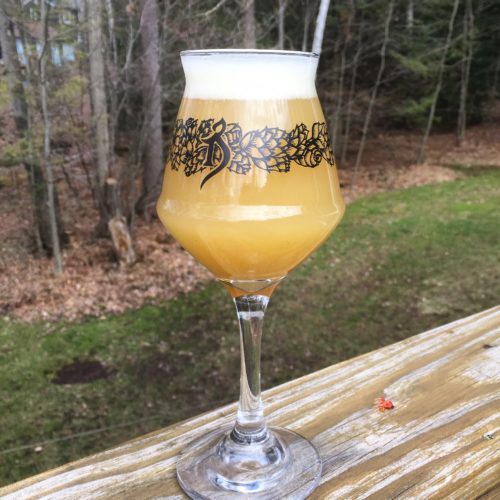Hazy IPAs: a perfect storm for diacetyl?
¶ by Rob FrieselWhile I’m still settling into my new Seattle home, I’ve tried to keep my brewing chops sharp through… let’s call it academic research. In other words, even though I’m dying to get my first Seattle brew under my belt, I haven’t figured out all of the ins-and-outs to getting there so I have settle for reading articles and watching HomebrewCon videos. Anyway — more to the point of the title here: one of the things I realized along the way is that Hazy (“New England”) style IPAs seem to be a perfect storm for diacetyl.

[Epistemic status: most statements backed up with citations, but some claims are speculative.]
It started with my study the metabolic pathways that lead to diacetyl production. 1 Combining this knowledge (particularly this paper by Chris White) with the recent information about dry hopping that Tom Shellhammer has been presenting, I started to draw some conclusions. 2
As we know, diacetyl is a normal byproduct of yeast fermentation. As fermentation is kicking off, yeast are producing the amino acid valine (among others); one of the intermediary compounds in valine production is acetolactate. Some of this acetolactate escapes the cell where it can be chemically (not enzymatically) transformed through oxidation into our friend diacetyl. Sufficiently healthy yeast, given enough contact time with the beer, will reabsorb most of the diacetyl that’s present, enzymatically reducing it into acetoin and then into 2,3-butanediol.
So far, so good. But this is a happy path.
When we’re talking about New England IPAs specifically, we tend to see a lot of brewers using English ale strains (thinking here of London III and derivatives) because of the claims around biotransformation while dry hopping. These English strains tend to be high diacetyl producers. 3 STRIKE ONE.
Then there’s the fact that stressed yeast tend to produce more acetolactate … while also failing to remetabolize it later in their lifecycle. This happens when there are insufficient nutrients in the wort. Ditto oxygen. As you can infer, higher gravity worts necessitate more nutrients and more oxygen. And boy howdy do NEIPA brewers love to make ’em doubles and imperials. STRIKE TWO.
Then there’s the heavy dry hopping going on. This one is kind of a double-whammy.
First, each time you dry hop is an opportunity for cold-side Oâ‚‚ to get in there. If you don’t have a good way of keeping the Oâ‚‚ out while you’re dry hopping, then any acetolactate that’s present in the beer has that much more fuel to oxidize into diacetyl. STRIKE THREE.
Plus, there’s the evidence out there about so-called hop creep. For the unfamiliar, “hop creep” is a phenomenon where you get sufficient amylase-type enzymatic to breakdown residual starches in the “finished” beer such that the yeast in suspension start fermenting again. In other words, an F.G. of 1.010 might turn out to drop to 1.008 or less. 4 Furthermore, this “bonus fermentation” is now in a more stressful environment for those yeast (i.e., less nutrients, less oxygen [if you did it right], lower pH, more alcohol) – meaning that they’re more likely to over-produce acetolactate and then fail to remetabolize the resulting diacetyl. STRIKE FOUR! 5
And lastly 6 there’s the whole “DRINK IT FRESH!” philosophy around NEIPAs. Which is not to say that “DRINK IT FRESH!” is bad advice here — those volatile hop aromas and oxidation concerns etc. But sloppy and/or rushed process on the part of the brewery introduces other opportunities for diacetyl to get in there. I’ll skip over sloppy dry hop additions and the Oâ‚‚ that could get in there because we already talked about that. However, if “DRINK IT FRESH!” translates into “grain-to-glass in 7 days!” (or however many days) then these breweries may not have allowed the yeast sufficient contact time to remetabolize the normal amounts of diacetyl. In other words, the beer might have hit F.G., but without a VDK test (or at least tasting the damn beer) then you might be sending a too-young beer to the canning line WHICH — there’s another place to get sloppy and introduce Oâ‚‚. 7 STRIKE FIVE!
All that said, at least these brewers are leaving some yeast in suspension with all that hop sludge, right? Because if they’re present then at least there’s a chance for them to scavenge the Oâ‚‚ and/or remetabolize the diacetyl in the can.
Except that those cans are kept cold, right? Anyway…
DRINK IT FRESH!
SOURCES:
- Diacetyl Time Line
- Diacetyl Rest « Brew Your Own
- “Flavour Biochemistry” (American Brewers Guild) [PDF 8]
- The Surprising Science of Dry Hopping – Lessons from Tom Shellhammer « Pat’s Pints
- Examination of Studies: Hopping Methods and Concepts for Achieving Maximum Hop Aroma and Flavor « Scott Janish
- Hop compound biotransformation: What’s it mean and what’s it taste like? « DRAFT
- Dry Hop Creep, Over-Carbonation and Diacetyl in Beer « BeerSmith
- The first revelation (to me) was that the yeast themselves do not produce diacetyl.[↩]
- Worth pointing out that I was doing this reading right around the same time that Scott Janish’s book came out. I understand from a friend that he talks about some of this stuff in there, but I haven’t read it myself yet. (YET!)[↩]
- Just kidding. They tend to produce a lot of acetolactate which oxidizes into diacetyl. In case you weren’t paying attention.[↩]
- And this is skipping over any “exploding cans” problems.[↩]
- Baseball fans: am I doing this right?[↩]
- Because I’m not going to get into the whole “Milkshake IPA” thing and fruit additions and Lacto. and Pedio. risks w/r/t/ the diacetyl that they produce.[↩]
- And once more for the people in the back: the Oâ‚‚ won’t just oxidize the beer but is “fuel” for any remaining acetolactate to make its way into diacetyl form.[↩]
- I have a copy, but not mine to share.[↩]
Leave a Reply